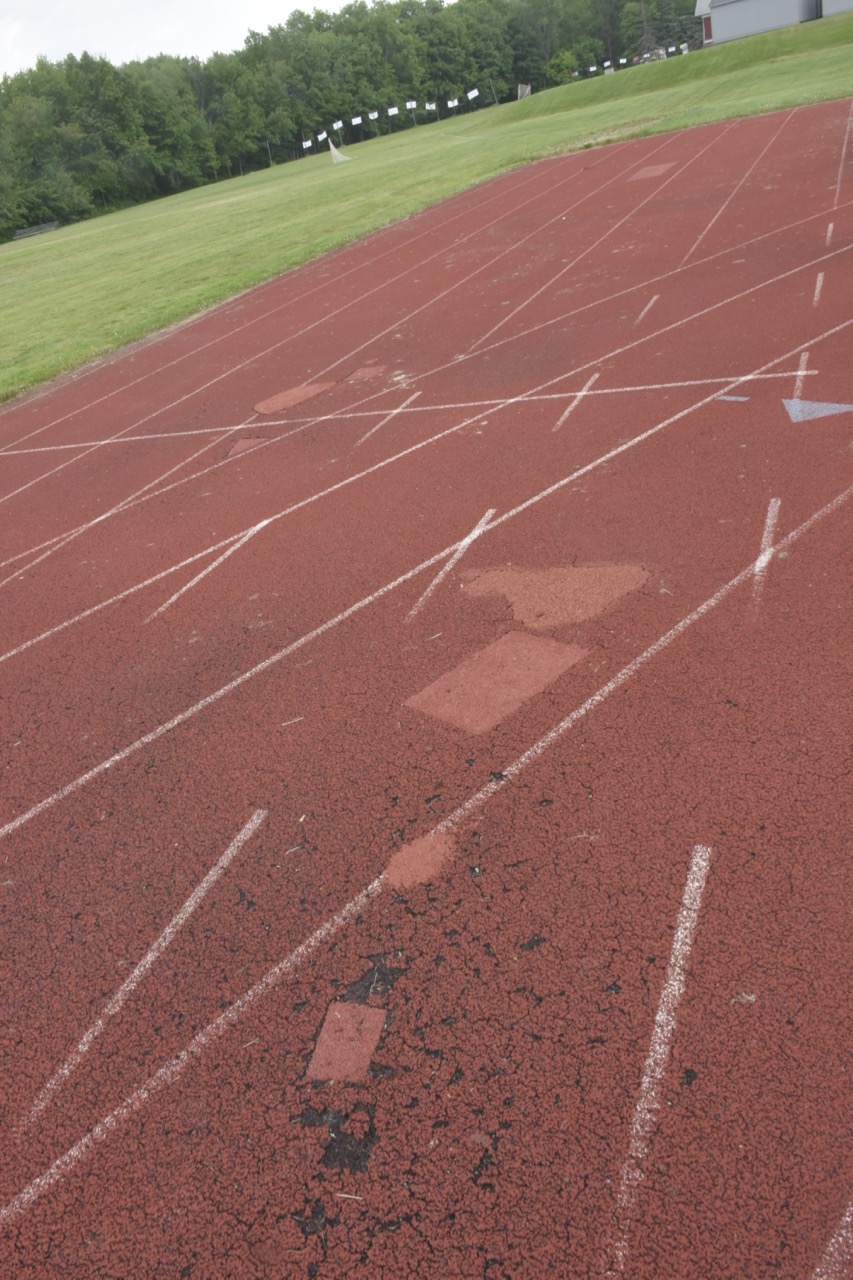Opinion: Setting Outselves Up for Success on the ARHS Track and Field Project

Pitting and patching dominate the surface of the Amherst High School track. Adopting Option 2 would repair and reorient the track and install a new grass field in the center. Option 3 would do the same but with an artificial turf field. Photo: Art Keene
Jennifer Shiao’s School Committee Blog
Editor’s note: Jennifer Shiao is a member of the Amherst School Committee. Her original posts can be found here. An archive of her blog posts in The Indy can be found here.

I’m fairly certain we can all agree that the Amherst Regional High School (ARHS) track, and the field inside the track, are in poor shape. The surface of the six-lane track is significantly degraded, the field is not regulation size and is in poor condition, and the orientation of the facility is such that players have to deal with the sun in their eyes during the time when games are taking place.
There is currently a project in the works that aims to re-orient the track and field 90 degrees, expand the track to eight lanes, and create a regulation-sized field so that tournament competitions can be held on it. This project will be expensive, AND it is sorely needed. It’s not an exaggeration to say that a generation of student athletes have had to use a deficient track and field facility. And right now it’s been almost two years since the project was first voted on by the Regional School Committee (RSC), in March ‘22.
The money to pay for this project is going to come from a number of different sources. A large chunk of it ($1.5 million) is going to be appropriated from the four towns in our region (Amherst, Leverett, Pelham, Shutesbury). Each town will contribute a proportionate amount that they will acquire through borrowing. When the RSC voted to approve that appropriation on March 15, 2022, we included a requirement that if another $2.2 million can be raised through other sources, then the project will include a synthetic playing field.
So, what’s happening now?
It’s unclear at this time if that additional $2.2 million will be raised in time, and even if it is, it may not be sufficient. The total cost estimate for a re-oriented track and field with synthetic turf was reported to be $4.7 million in March ‘22. Cost estimates are very likely to be higher now, almost two years after that estimate was calculated.
At the November 28 RSC meeting, the committee discussed the fact that the $1.5 million from the four member towns is pegged to a synthetic turf project. In other words, because of the added requirement in the 3/15/22 motion about synthetic turf, the $1.5 million approved by the four towns could only be used on a project with synthetic turf. If it is determined that we don’t have enough funding for the synthetic turf project, and if the RSC decides to have natural grass on the field (which costs less), then we would need to vote another borrowing authorization and go back to the four member towns for them to approve it.
Leverett, Pelham, and Shutesbury are governed by a Select Board/Town Meeting form of government. The best time to go to those three towns with a request for appropriation is at their spring Town Meetings. Each of these towns holds a Town Meeting in the spring (Apr-May) of each year, during which a request like this can be approved.
In my opinion, the best way to set ourselves up for the success of this project is to rescind that vote from March 15, 2022, and vote for a new borrowing authorization that does not stipulate that the field will be synthetic turf. If we do this in time to get on the agendas for the spring 2024 Town Meetings for Leverett, Pelham, and Shutesbury, then we will have all options on the table to move forward with the track and field project.
If we don’t do this in time for the spring 2024 Town Meetings, it could significantly delay the project.
At the December 12 RSC meeting, the committee will discuss a motion to rescind the March 15, 2022 debt authorization vote. (This motion was made at the November 28 meeting, and the RSC voted to postpone it to December 12.)
I want to be crystal clear: I am 100% in favor of this project. It is sorely needed. We can’t allow another generation of student athletes to practice and compete on deficient facilities. I want this project to move forward with as few delays and roadblocks as possible. The best way to do that is to remove the requirement that synthetic turf be used.
This blog reflects my own views about the Amherst and Amherst-Pelham Regional School Committees – it does not represent the view of the committees, the district, or the superintendent. This blog complies with Open Meeting Law, as long as a quorum of School Committee members do not engage in deliberations in the comments. Comments are welcome. I may respond to comments, but I will not respond to all comments. Sign up here using the “follow blog via email” form to be notified when I post a new entry. You can email me at jennifer@jenniferamherst.org.

I always thought locking this project into only one option was unreasonable, just like many other decisions in this town. Please make this moves forward as quickly as possible by not locking us into a single option. Natural grass is perfectly fine. Also, this way the towns that blocked funds due to synthetic turf distaste would have no reason to deny funds now.